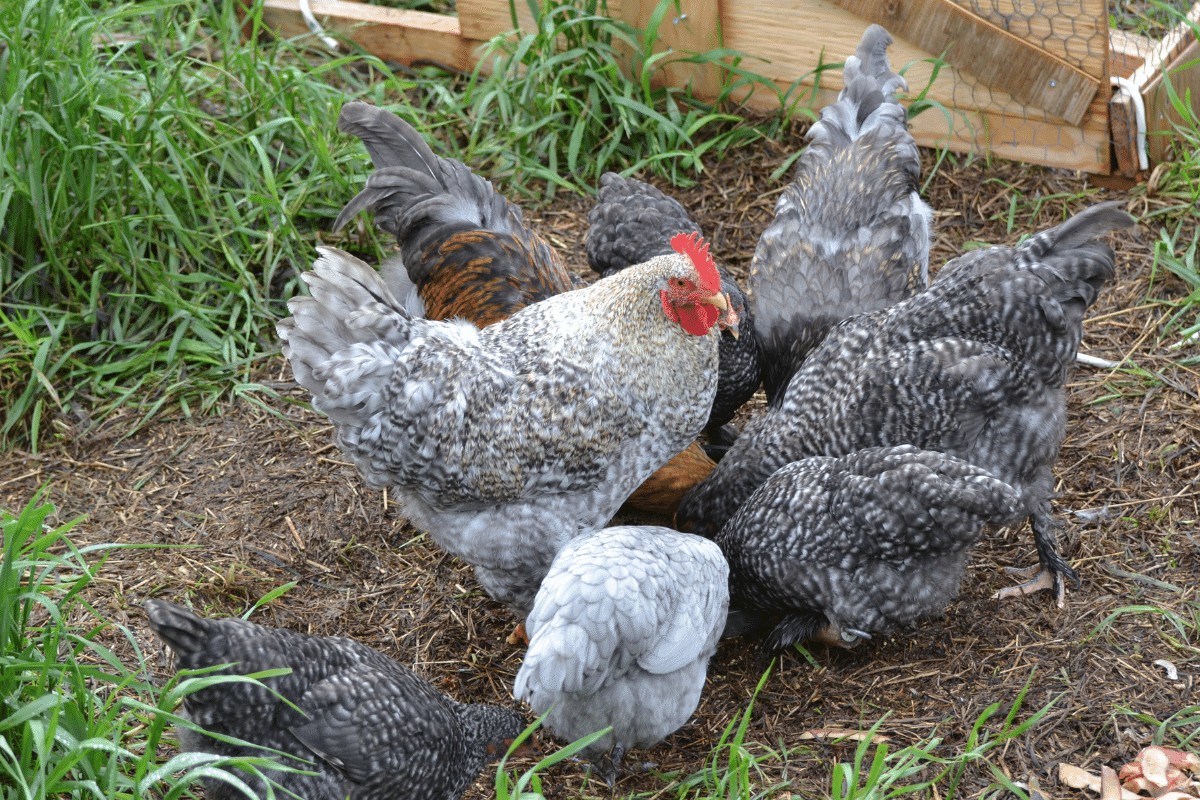One day I was spreading out the feed for my chickens, and I started to think about how people did this all before commercial chicken feed.
It’s such a staple of my hens’ diet; what would they have without it?
I started to wonder: What did chickens eat before commercial feed?
Before commercial feed, chickens free ranged for their food, eating plants and insects where they found them. On farms, they were often also fed table scraps, leftover grain from other farm animals, and cracked corn. Natural feeding would often result in fewer eggs overall.
I researched this question, so you don’t have to. If you want to provide a more natural style of diet, we’ll talk about this too.

Table of Contents
What Did Chickens Eat Before Commercial Feed?
Chickens are scrappy birds, and they’ll do pretty well on their own.
But if you’re interested in learning about chicken feed without commercial options, we’ll take the main parts they used to be fed on in detail in this section.
Free Range
The first big part of a hen’s diet without a commercial feed is what they find during the free-range process.
Even with a commercial diet, they’ll often find a lot to eat by simply scratching around.
Chickens will eat anything they can fit in their mouths and gullet.
As they peck around, they’ll find plants, seeds, and a lot of little insects.
The insects are how they get their protein without help from humans.
It’s not a lot, but it’s enough for them to live on.
If you’re not using commercial feed, make sure they have a large area to explore and peck.
This will help them find enough to eat. Small pens won’t work; they’ll pick the area clean of anything to eat quickly.
Speaking of bugs, learn about whether or not chickens can eat stink bugs safely. The answer shocked me!
Cracked Corn
Another staple of the pre-commercial feed chicken days was cracked corn.
Farmers back in the day (and still today) grew a lot of corn, and much of it was feed corn.
Where we live in Michigan, we’re surrounded by feed corn all the time.
When the corn kernels are dried and broken down (or cracked), they provide a great feed source for all animals, especially chickens.
Before commercial feed, farmers would keep huge storage spaces with dried corn and crack it as they went to feed their chickens.
Feed corn is relatively inexpensive, so if you want to crack your own, it won’t break the bank to look into this as another feed option.
Cracked corn has very little protein, so it won’t be enough on its own, though.
Leftover Grain
Grain is a staple of the chicken diet now, and it’s a part of commercial feed.
But it wasn’t always as readily available.
Grain was reserved for more productive farm animals, like cows.
Still, cows and horses and the like aren’t too neat. They spill grain all the time.
Free-range chickens will come along and eat the grain that falls from the larger animals’ eating troughs.
Table Scraps
Table scraps are a normal part of most chicken diets today, and it was key in chicken diets before a commercial feed.
Table scraps often include dairy products (milk and cheese) and meat, which is perfect for giving the chickens the protein they need to produce eggs on the regular.
Chicken farmers of old treated their poultry like they’d treat their pigs.
Both can live happily on leftovers, and both will eat anything you put in front of them.
Avoid junk food and processed food for a healthier diet, but any leftover cooked, and uncooked food is fair game.
How Do Non-Commercial Diets Affect Chicken Laying?
Non-commercial diets are more than enough for mot chickens to live long and healthy lives, but it does impact egg-laying in a negative way.
Eggs are made of protein, through and through.
Lower protein means fewer eggs.
Chickens with a non-commercial diet and less protein tend to be a bit skinnier (though this is offset with more table scraps), but they also lay much fewer eggs.
After talking to older folks whose grandparents owned chickens, the average amount of eggs per hen per year tended to be around 90 eggs back in the day.
This is a far cry from the 200 eggs we get on average nowadays.
Still, if you want to go more natural and less commercial, increase the protein offerings to help offset the egg loss and just accept you won’t have quite as many.
You may still have more than enough!
For more info on what you need, check out our detailed guide for how many chickens you need for a family with many charts and tables to help you decide what you need.


One Comment
[…] Learn what chickens used to eat before commercial feed by checking out our article at the link. […]